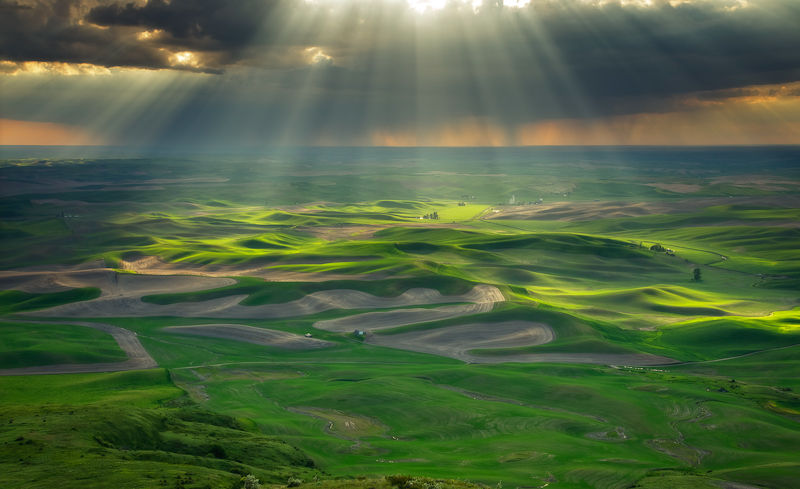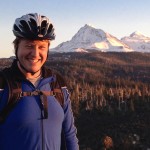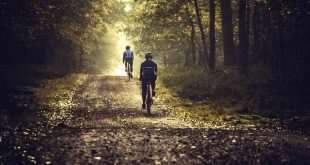The Palouse of eastern Washington and north Idaho is the region’s breadbasket and one the nation’s premier dryland farming regions, its 4,000 square miles of wind-sculpted hills unfolding under an endless sea of wheat and beans. Outside the raucous Greek Rows and stadiums of Washington State University in Pullman and The University of Idaho in Moscow, life is pretty quiet in this corner of the northwest.

And cycling is the best way to experience the Palouse up close, the roll of 700cm wheels more closely matching the pace of life. Winding roads, well paved and light on traffic, link tiny farming communities and make for a myriad of connect-the-dots loops. With a road atlas and plenty of water a cyclist can string together a lifetime’s worth of rides.
As a whole, the riding tends to be more reliable in the Spokane/Pullman corridor alongside the Idaho border. Further westward, in the Snake River drainage, the scarcity of towns make linking roads and finding supplies more challenging. Even so, although you can find a good cup of coffee or some Cougar Gold cheese in most communities, bike parts are scarce outside of Pullman and Spokane; plan accordingly.

And of course, there’s the wind. Windblown loess, a rich but fragile topsoil has, over the millenia, settled in drifts over basalt some 10,000 feet thick, the product of lava that flowed millions of years ago. The same unrelenting force that sculpted these storm swells of green can shave precious MPH off the bike computer. Ride long enough in the Palouse and you’ll start to wonder if there’s not always a headwind whichever direction you go, but, in fact, the wind blows primarily out of the southwest, as documented by the northeast-trending hills. Your best bet? Ride near sunrise or sunset for calm winds. As an added bonus, you’ll see the Palouse in its best light, the low angle sun highlighting the endless scalloped slopes – one of the northwest’s iconic sights.
Introduce yourself to the Palouse on a 25-miler that begins in the town of Palouse, a Cougar bedroom community 15 miles north of Pullman and the Washington State University campus. Ride south of town on Highway 27, a wide two-laner that tends to be quiet except on Cougar gamedays. Three miles in, turn right on Clear Creek Road. The pine- and fir-forested Kamiak Butte looms ahead. Kamiak Butte County Park boasts one of the last remnants of intact natural Palouse landscape and is worth a detour either mid- or post-ride. Otherwise, continue on Clear Creek to Highway 272 and 10 brisk miles back to Palouse. Afterward, take a few minutes to browse Palouse’s downtown. In addition to the requisite antique shops, the Roy M. Chatters Newspaper & Printing Museum is worth a browse.

For a longer ride, begin in Pullman and pull north to Clear Creek Road and proceed as above. This is the route that The Washington State University Cycling Club uses for its popular Tour de Lentil ride every August.
For riders based in Spokane, the 40-mile Valley Chapel Ride is a favorite. Beginning at 57th Avenue in the Moran Prairie area on the south edge of Spokane, head south on the wide-shouldered, well-paved Palouse Highway. Turn right on Valley Chapel Road and descend into the Latah Creek valley, an idyllic ponderosa-shaded drainage well off the beaten path. In May, blooms of golden currant, serviceberry and elderberry enliven the surroundings. A thigh-cramping half-mile climb at the 10-mile mark deposits riders onto quintessential Palouse prairie, complete with whitewashed cemetery and clapboard farmhouses. No huge climbs here, but plenty of rhythm-robbing hills will keep you from coasting. At 21 miles, turn on Highway 27, and at 29 miles turn left on to the Palouse Highway for a fast return trip of long, low-angle climbs and descents. The communities of Rockford (mile 21), Freeman (mile 27) and Valleyford (mile 30) make well-spaced rest stops.

Not for the faint of heart or lung, or the vertigo-inclined, the 23-mile ride (one way) ride from Palouse to Steptoe Butte rewards riders with the best vista in the Palouse, more than 1,000 feet above surrounding hills. From Palouse, ride north on Highway 27 through Garfield. Cross the railroad tracks, turn left on Hume Road and follow the signs to the park. The last three miles steadily corkscrew up and around Steptoe Butte, providing views all around to distract from the pain. At the top, enjoy a vantage point that’s graced many a calendar: to the west stretch hundreds of miles of farmland; to the east rise the Clearwater and St. Joe Ranges of north Idaho, the western outposts of the Rocky Mountains. Careful on the descent: in addition to being narrow and steep, the road is badly potholed in places.
For post-ride dining, stop by the Green Frog Café in Palouse. The café features local ingredients in its sandwiches, salads and grass-fed burgers, and the wine and beer menu includes a couple of Palouse pours. On weekend nights, come early for a chance at a table; the café hosts a popular open-mic night.

Unique accommodations can be hard to come by in the Palouse, but the Churchyard Inn is the best. A former Benedictine convent-turned-B&B, its six simply-appointed rooms fill up quickly on busy campus weekends, such as Mom’s Weekend in mid-April; plan ahead. Next door, check out the Saint Boniface Parish. The contentious construction of this iconic church in 1904 caused a rift in the congregation that led to the Benedictine Sisters moving out of their convent.
To stretch your legs on the drive home, head 80 miles west of Pullman to must-see Palouse Falls. Created when the Missoula Floods overran the Palouse River and carved a new course to the Snake River, the 198-foot falls is one of the state’s most impressive cataracts. A short paved trail follows the west side of the catch-basin, but a tangle of user-maintained trails offer closer looks of the main cascade and the smaller upper falls. This short hike will exhaust your store of superlatives.

Palouse Bike Shops
Spokane
Wheel Sport South 2820 E. 29th Ave. Spokane, WA 99223 Pullman B & L Bicycles 219 E. Main St. Pullman, WA 99163 An avid cyclist, Spokane-based outdoors writer Aaron Theisen has spent many an hour riding into the wind in eastern Washington. He’s currently working on Day Hiking Mt. St. Helens for Mountaineers Books.
An avid cyclist, Spokane-based outdoors writer Aaron Theisen has spent many an hour riding into the wind in eastern Washington. He’s currently working on Day Hiking Mt. St. Helens for Mountaineers Books.
 Javier Acosta is an award-winning, nationally published nature photographer whose work has appeared in Outdoor Photographer, Popular Photography, American Photo, Tahoe Weekly, Digital Camera World and many others. His goal is to promote and share the beauty of nature and its elements. When he’s not exploring nature’s elements he’s spending time with his number one passion, his family. Visit his website.
Javier Acosta is an award-winning, nationally published nature photographer whose work has appeared in Outdoor Photographer, Popular Photography, American Photo, Tahoe Weekly, Digital Camera World and many others. His goal is to promote and share the beauty of nature and its elements. When he’s not exploring nature’s elements he’s spending time with his number one passion, his family. Visit his website.
 AdventuresNW
AdventuresNW






One comment
Pingback: Wind-sculpted Palouse Hills | Aaron Theisen